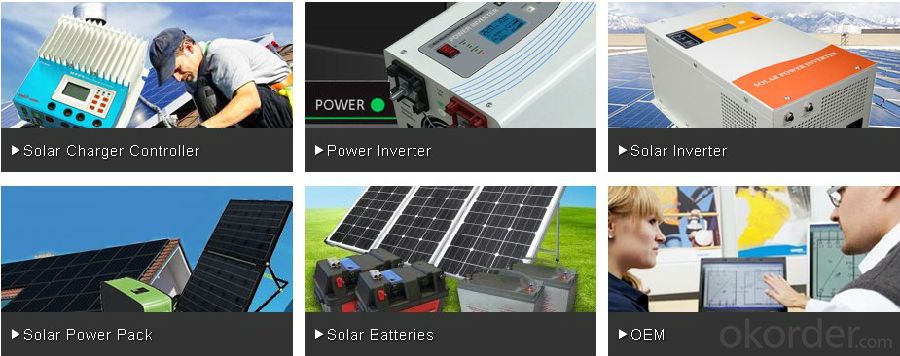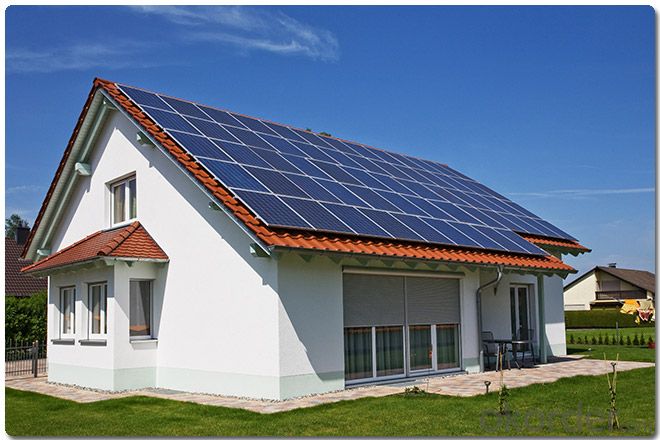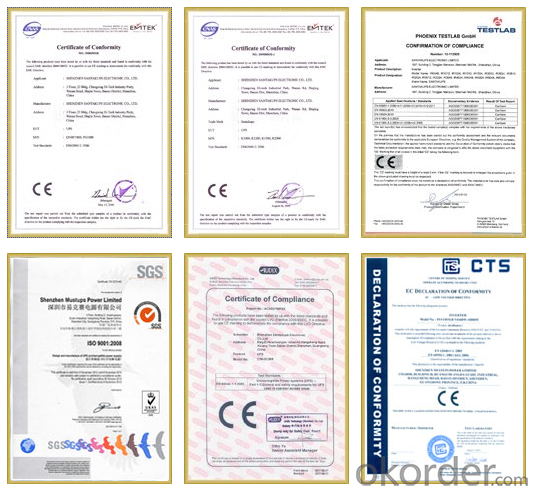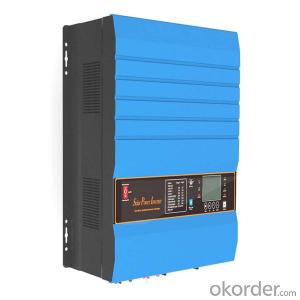10KW Pure Sine Wave Inverter New Function PV3500 Series 48V
- Loading Port:
- China main port
- Payment Terms:
- TT or LC
- Min Order Qty:
- 50 pc
- Supply Capability:
- 10000 pc/month
OKorder Service Pledge
OKorder Financial Service
You Might Also Like
Advances of Solar Inverter 10KW Pure Sine Wave Inverter New Function PV3500 Series 48V
Our solar inverters typically transfer to battery power in less than 16 milliseconds (less than 1/50th of a second).
Our solar backup electric systems use special high-quality electric storage batteries.
Main Features of Solar Inverter 10KW Pure Sine Wave Inverter New Function PV3500 Series 48V
.Power range 1kw-112kw
.12/24v/48v input optional
.Powerful Charge Rate Up to 100Amp
.Inbuilt pure copper transformer
.Pure sine wave output
.LED+LCD display
.MPPT solar charge controller 40A 45A 60A
.50/60HZ automatic sensing
.RS232 with free CD
.Battery priority function
.DC Start & Automatic Self-Diagnostic Function
.High Efficiency Design & “Power Saving Mode” to Conserve Energy
Specificationsc of Solar Inverter 10KW Pure Sine Wave Inverter New Function PV3500 Series 48V
Solar Inverter Model | 1.0KW | 1.5KW | 2.0KW | 3.0KW | 4.0KW | 5.0KW | 6.0KW | 8.0KW | 10.0KW | 12.0KW | |
Inverter output | Continuous output power | 1.0KW | 1.5KW | 2.0KW | 3.0KW | 4.0KW | 5.0KW | 6.0KW | 8.0KW | 10.0KW | 12.0KW |
Surge rating (20ms) | 3.0KW | 4.5KW | 6.0KW | 9.0KW | 12.0KW | 15.0KW | 18.0KW | 24.0KW | 30.0KW | 36.0KW | |
Output waveform | Pure sine wave/ same as input (bypass mode) | ||||||||||
Nominal efficiency | >88% (peak) | ||||||||||
Line mode efficiency | >95% | ||||||||||
Power factor | 0.9-1.0 | ||||||||||
Nominal output voltage RMS | 100-110-120VAC/220-230-240VAC | ||||||||||
Output voltage regulation | ±10% RMS | ||||||||||
Output frequency | 50Hz ± 0.3Hz / 60Hz ± 0.3Hz | ||||||||||
Short circuit protection | Yes (1sec after fault) | ||||||||||
Typical transfer time | 10ms (max) | ||||||||||
THD | < 10% | ||||||||||
DC input | Nominal input voltage | 12.0VDC / 24.0VDC / 48.0VDC | 24.0VDC /48.0VDC | 48.0VDC | |||||||
Minimum start voltage | 10.0VDC /10.5VDC for12VDC mode | *2 for 24VDC, *4 for 48VDC | |||||||||
Low battery alarm | 10.5VDC /11.0VDC for12VDC mode | ||||||||||
Low battery trip | 10.0VDC /10.5VDC for12VDC mode | ||||||||||
High voltage alarm | 16.0VDC for12VDC mode | ||||||||||
Low battery voltage recover | 15.5VDC for12VDC mode | ||||||||||
Idle consumption-search mode | <25W when power saver on. (refer to table) | ||||||||||
Charger | Output voltage | Depends on battery type (refer to table 2.5.2) | |||||||||
Charger breaker rating | 10A | 15A | 20A | 20A | 20A | 30A | 30A | 40A | 40A | 40A | |
Max charge power rate | 1/3 Rating power (refer to table 2.5.3) | ||||||||||
Battery initial voltage for start | 10-15.7VDC for 12VDC mode | *2 for 24VDC, *4 for 48VDC | |||||||||
Over charge protection S.D. | 15.7VDC for 12VDC mode | ||||||||||
BTS | Battery temperature sensor (optional) | Yes (refer to the table) Variances in charging voltage & S.D. voltage base on the battery temperature. | |||||||||
Bypass & protection | Input voltage waveform | Sine wave (grid or generator) | |||||||||
Nominal voltage | 110VAC | 120VAC | 220VAC | 230VAC | 230VAC | ||||||
Max input AC voltage | 150VAC for 120VAC LV mode; 300VAC for 230VAC HV mode. | ||||||||||
Nominal input frequency | 50Hz or 60Hz | ||||||||||
Low freq trip | 47 ± 0.3Hz for 50Hz; 57 ± 0.3Hz for 60Hz | ||||||||||
High freq trip | 55 ± 0.3Hz for 50Hz; 65 ± 0.3Hz for 60Hz | ||||||||||
Overload protection (SMPS load) | Circuit breaker | ||||||||||
Output short circuit protection | Circuit breaker | ||||||||||
Bypass breaker rating | 10 | 15 | 20 | 30 | 40 | 40 | 40 | 50 | 63 | 63 | |
Transfer switch rating | 30Amp for UL & TUV | 40Amp for UL | 80Amp for UL | ||||||||
Bypass without battery connected | Yes (optional) | ||||||||||
Max bypass current | 30Amp | 40Amp | 80Amp | ||||||||
Solar charger | Rated voltage | 12.0VDC / 24.0VDC / 48.0VDC | |||||||||
Solar input voltage range | 15-30VDC / 30-55VDC / 55-100VDC | ||||||||||
Rated charge current | 40-60A | ||||||||||
Rated output current | 15A | ||||||||||
Self consumption | <10mA | ||||||||||
Bulk charge (default) | 14.5VDC for12VDC mode | *2 for 24VDC, *4 for 48VDC | |||||||||
Floating charge (default) | 13.5VDC for12VDC mode | ||||||||||
Equalization charge (default) | 14.0VDC for12VDC mode | ||||||||||
Over charge disconnection | 14.8VDC for12VDC mode | ||||||||||
Over charge recovery | 13.6VDC for12VDC mode | ||||||||||
Over discharge disconnection | 10.8VDC for12VDC mode | ||||||||||
Over discharge reconnection | 12.3VDC for12VDC mode | ||||||||||
Temperature compensation | -13.2mVDC/℃ for12VDC mode | ||||||||||
Ambient temperature | 0-40℃ (full load) 40-60℃ (derating) | ||||||||||
Mechanical specifications | Mounting | Wall mount | |||||||||
Inverter dimensions (L*W*H) | 388*415*200mm | 488*415*200mm | 588*415*200mm | ||||||||
Inverter weight (solar chg) KG | 21+2.5 | 22+2.5 | 23+2.5 | 27+2.5 | 38+2.5 | 48+2.5 | 49+2.5 | 60+2.5 | 66+2.5 | 70+2.5 | |
Shipping dimensions (L*W*H) | 550*520*310mm | 650*520*310mm | 750+520+310mm | ||||||||
Shipping weight (solar chg) KG | 23+2.5 | 24+2.5 | 25+2.5 | 29+2.5 | 40+2.5 | 50+2.5 | 51+2.5 | 62+2.5 | 68+2.5 | 72+2.5 | |
Display | LED+LCD | ||||||||||
Standard warranty | 1 year | ||||||||||
Pictures of Solar Inverter 10KW Pure Sine Wave Inverter New Function PV3500 Series 48V

Solar Inverter's Application

Warranty of Solar Inverter 10KW Pure Sine Wave Inverter New Function PV3500 Series 48V
OKorder’s Products provides a 1~3 year limited warranty (“Warranty”) against defects in materials and workmanship for its Uninterruptible power supply, Power inverter/chargers, Solar charge controllers, Battery Products (“Product”).
The term of this Warranty begins on the Product(s) initial purchase date, or the date of receipt of the Product(s) by the end user, whichever is later.
This must be indicated on the invoice, bill of sale, and/or warranty registration card submitted to MUST-Solar.
This Warranty applies to the original MUST-Solar Product purchaser, and is transferable only if the Product remains installed in the original use location.
Certificates of Solar Inverter 10KW Pure Sine Wave Inverter New Function PV3500 Series 48V

FAQ of Solar Inverter 10KW Pure Sine Wave Inverter New Function PV3500 Series 48V
How to guarantee the quality of the products?
We have established the international advanced quality management system,every link from raw material to final product we have strict quality test;
We resolutely put an end to unqualified products flowing into the market.
At the same time, we will provide necessary follow-up service assurance.
How long can we receive the product after purchase?
In the purchase of product within three working days, We will arrange the factory delivery as soon as possible.
- Q:Can a solar inverter be used with multiple solar arrays?
- Yes, a solar inverter can be used with multiple solar arrays. In fact, many solar power systems consist of multiple arrays connected to a single inverter. The inverter's role is to convert the DC power generated by the solar arrays into usable AC power for household or grid consumption. By connecting multiple arrays to a single inverter, it allows for greater energy production and efficiency, making it a common practice in larger solar installations.
- Q:Can a solar inverter be used with different AC voltages?
- Yes, a solar inverter can be used with different AC voltages. However, it is important to ensure that the inverter is compatible with the specific AC voltage and frequency requirements of the power grid it will be connected to.
- Q:What are the different output waveforms of a solar inverter?
- The different output waveforms of a solar inverter can vary depending on the type and design of the inverter. The most common output waveform is a modified sine wave, which is a stepped approximation of a true sine wave. However, some solar inverters can produce a pure sine wave output, which is an exact replication of the smooth sinusoidal waveform found in utility power. Additionally, there are also solar inverters that can produce a square wave or a quasi-square wave output waveform. The choice of output waveform depends on the specific application and the compatibility requirements of the connected appliances or equipment.
- Q:What is the maximum operating altitude for a solar inverter?
- The maximum operating altitude for a solar inverter depends on the specific model and manufacturer. However, most solar inverters are designed to operate effectively up to an altitude of around 13,000 feet (4,000 meters) above sea level.
- Q:How is a solar inverter different from a regular inverter?
- A solar inverter is specifically designed to convert the DC (direct current) electricity generated by solar panels into AC (alternating current) electricity suitable for use in homes and businesses. On the other hand, a regular inverter is mainly used to convert DC electricity from batteries or other sources into AC electricity. Therefore, while both inverters convert electricity from one form to another, a solar inverter is tailored for the unique requirements of solar power systems.
- Q:What is the maximum number of solar panels that a solar inverter can support?
- The maximum number of solar panels that a solar inverter can support depends on the specific model and its capacity. However, most solar inverters are designed to support a certain capacity or power rating, rather than a specific number of panels. The capacity of the solar inverter, measured in kilowatts (kW) or megawatts (MW), determines the maximum power output it can handle. The number of panels that can be connected to the inverter depends on the power rating of each panel. So, it is best to consult the manufacturer's specifications or seek professional advice to determine the maximum number of panels that can be supported by a specific solar inverter.
- Q:How does a solar inverter handle voltage sag and swell?
- A solar inverter handles voltage sag and swell by continuously monitoring the input voltage from the solar panels and adjusting its output voltage accordingly. In the case of voltage sag, when the input voltage drops below a certain threshold, the inverter boosts the voltage to maintain a stable output. Similarly, in the case of voltage swell, when the input voltage exceeds a certain limit, the inverter reduces the voltage to prevent any damage to the connected devices. This process ensures that the solar inverter consistently provides a steady and safe electrical supply.
- Q:What are the installation requirements for a solar inverter?
- The installation requirements for a solar inverter typically include a suitable mounting location, proper ventilation, and a stable electrical connection. The inverter should be installed in a shaded area, away from direct sunlight and extreme temperatures. It should be mounted securely on a sturdy surface, such as a wall or a rack. Adequate ventilation is necessary to dissipate heat generated during operation. Additionally, the inverter must be connected to the electrical panel or grid with the appropriate wiring and circuit breakers, following local electrical codes and regulations.
- Q:PV grid-connected inverter can directly load it?
- Grid-connected inverter is usually equipped with island protection function, can only receive the power grid, if the load directly, the output is disconnected.
- Q:What are the main components of a solar inverter?
- The main components of a solar inverter typically include the DC input, MPPT (Maximum Power Point Tracking) system, inverter circuit, transformer, and AC output.
1. Manufacturer Overview |
|
|---|---|
| Location | |
| Year Established | |
| Annual Output Value | |
| Main Markets | |
| Company Certifications | |
2. Manufacturer Certificates |
|
|---|---|
| a) Certification Name | |
| Range | |
| Reference | |
| Validity Period | |
3. Manufacturer Capability |
|
|---|---|
| a)Trade Capacity | |
| Nearest Port | |
| Export Percentage | |
| No.of Employees in Trade Department | |
| Language Spoken: | |
| b)Factory Information | |
| Factory Size: | |
| No. of Production Lines | |
| Contract Manufacturing | |
| Product Price Range | |
Send your message to us
10KW Pure Sine Wave Inverter New Function PV3500 Series 48V
- Loading Port:
- China main port
- Payment Terms:
- TT or LC
- Min Order Qty:
- 50 pc
- Supply Capability:
- 10000 pc/month
OKorder Service Pledge
OKorder Financial Service
Similar products
New products
Hot products
Hot Searches
Related keywords































